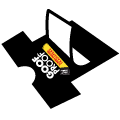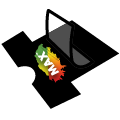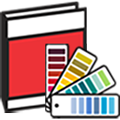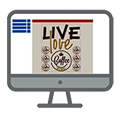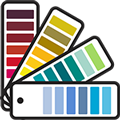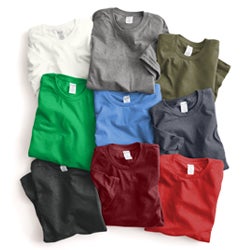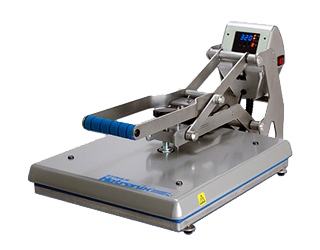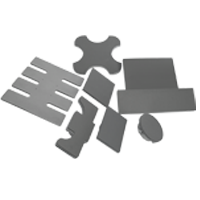HTV vs Screen Printed Transfers | What To Use When?
Browse Video Categories
Transfer Application | Artwork & Apparel | Easy View Tutorials | Webinars | Ordering Tips | Business | Heat Presses
Hey friends! Dave here with Transfer Express and today we are doing a deep dive into heat transfer vinyl and our screen printed transfers to help you find out which one is right for your next project. We're going to cover everything from what to use when, to set up and heat printing, along with some of the different application techniques and effects that you could get with both of these decoration methods.
Are you ready to learn? So am I!
First, let's cover both of these decoration methods and while both are applied with a heat press, screen printed transfers are produced with plastisol inks.
These are the same durable inks that you commonly find printed directly to the fabric when you think of a graphic tee.
These transfers come pre-printed on carrier sheets just like this, ready to apply with your heat press.
For the art, we used one of the 10,000 plus layouts and clipart that we have available in our Easy View online designer which is absolutely free to use on TransferExpress.com.
If you have your own art, you could upload it as well, but with this library of print ready art, it almost completely eliminates the need for artwork or svg catalogs available for purchase across the web.
These are available in over 70 standard ink colors with custom Pantone matching available for just an additional fee.
Screen printed transfers are great for all the intricate detail, distressing, or complex images that could be very time consuming when weeding with vinyl.
I should mention that there's minimum quantities here on the screen printed transfers from us at Transfer Express. The minimum quantity is just six sheets, though, so it's very affordable and accessible to almost anybody.
These 11.5” x 14” sheets are really where the value comes in. We call these gang sheets because we're able to gang or group the artwork together to maximize the printing space on our sheet and lower the print cost of each image that you need printed.
You see on this sheet we have five total images for t-shirts or tote bags, left chest prints, or even some prints on aprons. You're only charged for the sheet and not the ink you use, so use all of the space you can to take full advantage of your print costs.
Turn times are quick, too. They're as short as one day for these one color prints but, of course, increase as you add additional colors or upload your own art, which brings us to one of the last benefits we could talk about today – the ease of printing multiple colors.
There's no layering or aligning any of your graphics. They come pre-printed, ready to apply.
You're going to see in just a few minutes how quick and easy these are to press – just four seconds per print at 365 degrees with a hot peel, which makes larger runs super quick and efficient – so quick that we even made a short video on it that's going to be linked right here and down in the description below.
Heat transfer vinyl, or htv as it's commonly referred to, is a vinyl material that is cut to shape using a cutter.
Today, we have one of the most popular machines for beginners. This is a Cricut Air Explorer II. Htv is available in a wide variety of standard colors, just like this cyan blue that we have, but it can be prohibitively expensive to custom Pantone match colors for a custom material.
it has one pigmented side with the color and an adhesive side, which is the heat activated adhesive which then attaches the graphic to the fabric of the shirt.
For artwork, you will have to rely on a designer or a catalog of cut ready art. Typically you'll see these in svg files for the cutting software in addition to learning the application.
With a heat press, you're going to need to know how to operate the software and hardware of your cutter as well.
There are specific settings on your cutter for specific substrates. For the best results, you need to make sure you're using the right one. We're just going to be using the simple iron-on setting here on the Cricut today.
The huge benefit of htv is that there are no minimum quantities and with a cutter at home you could produce a printed shirt very, very quickly.
Going from design to printed shirt in under an hour is an incredibly powerful tool for any apparel decorator. You don't have to worry about the expensive startup or maintenance costs of having a direct-to-garment printer.
With cut vinyl, you will have to remove the excess vinyl from the carrier sheet after it's cut, or as it's known in the industry as weeding. Weeding is easy on simple images or block text, but it can be time consuming on larger quantities or detailed images.
For our example that we're using here today, this semi-complex image is not the quickest to weed and extra care needs to be taken to ensure no detail is accidentally removed from the carrier sheet.
Once we've removed all the extra vinyl, we're left with just the image on the sheet and now we're ready to press.
This vinyl applies between 280 and 330 degrees for 8 to 12 seconds and it peels warm, just waiting three to five seconds after the press opens.
Or you could wait even longer and peel cold if you want to press all the shirts in your run then go back and peel all the carriers off.
For printing multiple colors with layering on the vinyl, you can tack down the background colors for two seconds and then place the next color on top of it and press for the full application.
So with what we've learned about each one of these techniques, let's talk about what to use when.
Htv is perfect for projects in low quantities or one-offs. It's incredibly affordable and versatile in its application and very quick for you to make t-shirts at home.
In addition to your heat press, you'll need to purchase a vinyl cutter so plan for a little bit more of an added expense, along with any commonly used colors in the vinyl that you'll want to keep stock of on hand.
For large quantities, it can get time consuming and tedious to weed or align a whole bunch of those two or three color prints cutting into your time and profit margin.
Now screen printed transfers come in where the vinyl leaves off.
These transfers are awesome because you could order on demand when you need them with no need for stocking any material to keep in your house or your shop.
Of course, with a minimum quantity of six, they can be costly to produce one offs or those smaller quantities, but you'll have plenty of extras on hand.
And for the cost of just a couple rolls of vinyl, you'll have those extra prints while you won't have to weed, you do have to wait for the transfers to be produced and shipped to you, which like mentioned before, can be as quick as one business day.
Where screen printed transfers really shine with huge profitability are those larger runs of 12 or more shirts, especially if you're printing something like this, where we could fit multiple images, or two of this large graphic on one sheet. That's lowering the total quantity of sheets you'll need.
If you need just 12 of these and you could fit two up on a sheet, then you're only ordering six sheets.
But enough talking. Let's apply both of these and compare how the quality turns out. We're gonna take two 100% cotton t-shirts here and press our designs on them using our trusty Hotronix 16x20 Auto Open Clam shell press.
First, we're going to press our vinyl design and we're going to go with 320 degrees for 12 seconds, with and a warm peel. Our press is already configured and then next, we'll bump the temperature up to 365. For our Goof Proof screen printed transfers, we'll apply these at four seconds, after cutting out the design from the gang sheet.
We'll first start with our vinyl design by taking our shirt and we're just going to thread this onto our heat press. We have the Auto Clam on the Caddie Stand which allows it to be fully threadable with our t-shirts, just making it super easy to align and register our shirt on the lower platen.
Once our shirt is on the press, we'll go ahead and pre-press this for three to five seconds, just removing any moisture and wrinkles from the garment, giving our vinyl a great surface to adhere to. We'll go ahead and take our transfer and lay it on our garment. The great thing about vinyl is that you could see through the clear carrier sheet and know exactly where you're going to be placing the graphic and how it's going to look on the shirt.
We're going to take a cover sheet and we'll just go ahead and cover over the transfer.
We'll go ahead and press this for 12 seconds. Because this vinyl is a warm peel, we'll wait three to five seconds after the press opens to peel the transfer carrier away. Go ahead and peel, and just like that, we have our printed t-shirt.
Before we get into in-depth looks at the quality, we'll go ahead and press our Goof Proof. This time, we're gonna have to bump the temperature up to 365 degrees. It should just take this Auto Clam just a couple minutes to get up to that temperature, since we are already at 300.
Always check the settings for the material that you are printing. Our Goof Proof is going to apply at a much quicker four to six seconds.
Our screen printed transfer here will apply very similarly, except we'll have to flip it around and have the carrier paper facing up.
Just take it like this and flip it all the way around. We're gonna press this for four to six seconds at that 365° and we're going to peel this immediately hot, when the press opens.
Once the press opens, we'll go ahead and hot peel and we have our screen printed shirt.
Now that we've got these two side by side, you can see the slightly darker color that we had of our vinyl and here with the lighter color with the Goof Proof transfer.
To the hand, they're both very soft, although, you could feel the vinyl just a little bit more than you can the Goof Proof screen printed transfer.
If we reach on the inside, the print is barely there on the Goof Proof, while you can feel just a little bit of the detail here on the inside of the vinyl. You could feel the inside a little bit more as that vinyl kind of holds together as I put some pressure on.
It doesn't have nearly as much flex and rebound that the Goof Proof here does. With the look, you can see the garment pattern through both the Goof Proof screen printer transfer and the vinyl on there. The goof proof does have a slightly less matte look, but more typical of a traditional screen printed shirt, where the vinyl has a nice matte smooth finish.
If we were doing 12 of these shirts, you're talking $55 minimum for one color of the Easy Prints artwork here. And if we're doing 12 of these on vinyl, you're looking at a $40 to $60 dollar material cost, so right in that same range.
Two great ways to decorate a t-shirt, but it all depends on the complexity of your artwork, the textures that you have there along with the quantity and colors that you have printed.
I hope that you guys learned about these two different decoration methods today and which one is right for your next project.
If you have any questions please leave them in the comments section or email us.
Also, make sure that you're subscribed to stay up to date on all of the helpful t-shirt printing tips that we're dropping every single week.
Until next time, I'm Dave – happy pressing!

